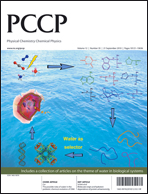Electronic structure of 9-mesityl-10-methylacridinium in ground and excited states: charge-shift mechanism introduced by counter anion shift†
Abstract
The origin of the lowest triplet states—locally excited or charge shifted (TLEvs. TCS)—is a key point in the discussion of the charge shift phenomena of 9-mesityl-10-methylacridinium (see Fukuzumi et al. Phys. Chem. Chem. Phys., 2008, 10, 5159 vs. Benniston et al., Phys. Chem. Chem. Phys., 2008, 10, 5156). Coordination of the anion on the


 Please wait while we load your content...
Please wait while we load your content...